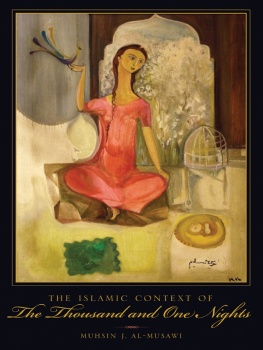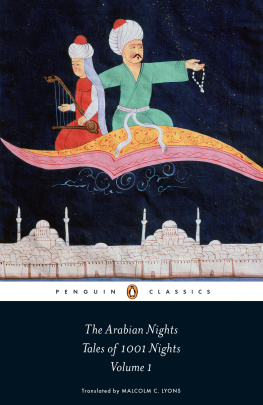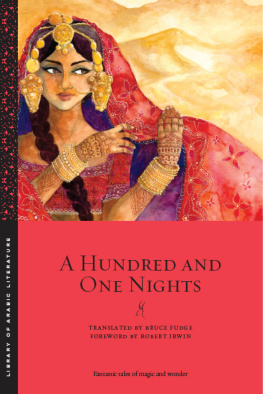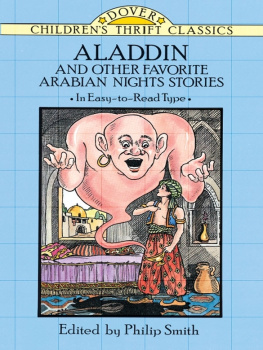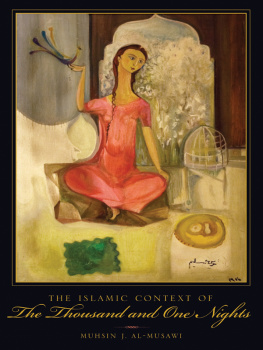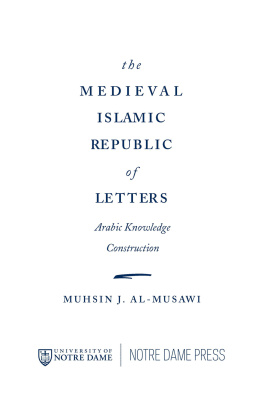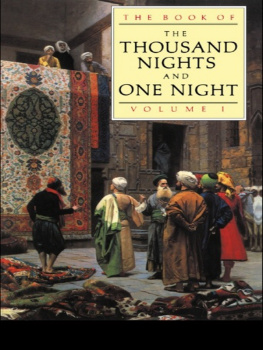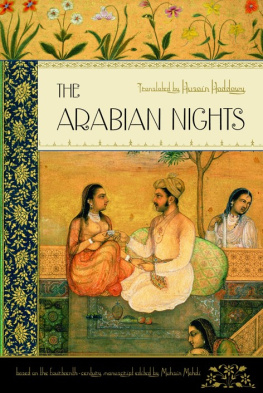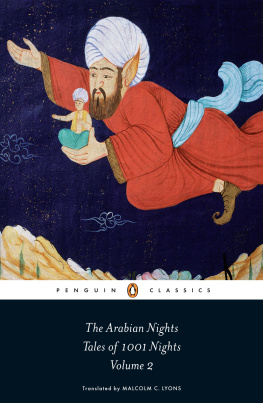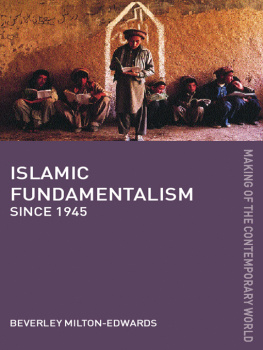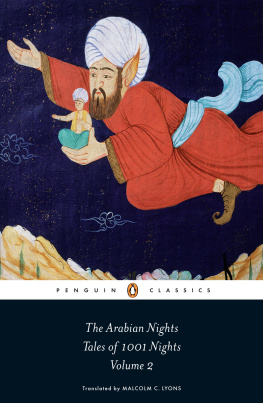THE ISLAMIC CONTEXT OF
THE THOUSAND AND ONE NIGHTS
THE ISLAMIC CONTEXT OF
THE THOUSAND AND ONE NIGHTS
Mushin J. al-Musawi
COLUMBIA UNIVERSITY PRESS
NEW YORK

Columbia University Press
Publishers Since 1893
New York, Chichester, West Sussex
cup.columbia.edu
Copyright 2009 Columbia University Press
All rights reserved
E-ISBN 978-0-231-51946-5
Library of Congress Cataloging-in-Publication Data
Musawi, Muhsin Jasim.
The Islamic context of the Thousand and one nights / Muhsin al-Musawi.
p. cm.
Includes bibliographical references and index.
ISBN 978-0-231-14634-0 (cloth : alk. paper)ISBN 978-0-231-51946-5 (e-book)
1. Arabian nights. 2. Islam in literature. 3. Arabic literature
Islamic influences. I. Title.
PJ7737.M75 2009
398.220953dc22 2008039653
A Columbia University Press E-book.
CUP would be pleased to hear about your reading experience with this e-book at .
CONTENTS
T HIS BOOK has been living with me for some time. I began working on it in 1991, when I was in Yemen at an University. I continued working on it in Tunisia, at the University of Manouba, from 1993 to 2000. Throughout those years, I collected most of the material needed for my research. I began writing when I came to Columbia, where I found that its scope went well beyond my early concerns and plans. The book as it appears now engages issues and queries that long must have been in the minds of scholars and readers, especially regarding issues of morality, ethics, and religion.
I am grateful to the librarians at Manouba University for their help in procuring much needed material. Apart from many seminars I attended or read papers at, I benefited from the intelligent discussions at the Columbia University Arabic Studies seminar, and I am most grateful to the Columbia University Seminars administration and Professor Robert Belknap, for a generous grant that helped cover proofreading and indexing expenses. In this respect, I should acknowledge the diligence of Robert Riggs of the University of Pennsylvania, Jason Frydman of Columbia University, and my assistant Ryan Damron, for careful proofreading and editorial suggestions. I benefited from my students at Columbia University who, in the graduate seminar on the Thousand and One Nights, were thoroughly engaged in debates about issues pertaining to this book. I thank Kelly Boyce, Namrata Kanchan, Elias Abrar, Akash Kumar, Chermaine Lee, Suad Muhammad, Elizabeth Nolte, and Stephanie Saporito. I give special thanks to the Columbia University outside readers who read the manuscript and made very pertinent remarks and suggestions. Thanks are due to Roger Allen and William Granara for helpful insights. Richard Bulliet and Rashid Khalidi of Columbia University encouraged the publication of this book; to them goes my sincere gratitude. Portions of the last three chapters appeared in an early form in the Journal of Arabic Literature: Abbasid Popular Narrative: The Formation of Readership and Cultural Production, JAL 38 (2007): 261292; Scheherazade; Nonverbal Narratives, JAL 36, no. 3 (2005): 338362; and The Mansion and the Rubbish Mounds: The Thousand and One Nights as Popular Literature, JAL 35, no. 2 (2004): 329367. I am grateful to Brill Academic Publishers for copyright permissions. I also thank Wendy Lochner, Anne McCoy, Christine Mortlock, Rob Fellman, and Michael Haskell from Columbia University Press for their support and care.
S EVERAL THINGS prompted this study of Islam in the Thousand and One Nights. There is, first, among academics and laypeople, an increasing interest in everything Islamic. The Thousand and One Nights, or the Arabian Nights Entertainments, as it was called in English by its first Grub Street translator, has always been considered one of the worlds most entertaining books, but its title and concerns are Arab-Islamic, and thus it has drawn and should draw more attention as a repository of popular memory, collective consciousness, and cultural dynamics. We know that eighteenth-century and nineteenth-century Europeans, in the wake of the colonial incursions in the Arab east and India, were also drawn, in part, to the collection and its many abridgments and translations for this reason. The tales are part of a collective memory: they are the imaginative recreations or depictions of bygone things and images. They contain nostalgia and reality, dream and fact. But these elements are blended in a melting pot that can still overflow in spontaneous storytelling. Once written down, however, they were tampered with, scrutinized, and had their contents censored in various ways. The Blq edition (1835), for example, contains a tale in which the term Rfi appears, although this pejorative use in reference to Shs was not employed by earlier storytellers, as we see in Antoine Gallands fourteenth-century version, for example. The art of storytelling emerges as triumphant, pacifying Shahrayar, the king of China, and every other person, including the caliph himself, who listens to adventures with rapture and offers in the end his own gifts of reconciliation and rapprochement. The terms of storytelling production operate here as well, as the storyteller pampers the expectations of his audience and caters to feelings that otherwise might be hurt by direct or antagonizing religious or political overtones. The enveloping Islamic context is one of mercy, generosity, playfulness, and humor. Hence the perennial charm of the tales, a charm that surpasses historical record and hagiography.
Yet the tales have something deeper that eludes the superficial and pragmatic search for the depiction of probable customs, ways of life, and habits of thought. Even such cycles as the frame tale of Scheherazade and Shahrayar or the mendicants itinerary of fortune, misfortune, and repose may hold other meanings, ones the French and English romantics felt but were not keen on exploring. Scheherazades counternarrative, employed to defuse the morose kings vengeful and vindictive plan, works within the parameters of Islamic faith, which objects to wholesale denunciations. The young abducted bride in the frame tale whom the ifrit assumes to be a virgin proves to have experienced many extramarital relations, affirming the two kings belief in the impossibility of faithfulness among women. This point should be disapproved of by queen Scheherazade, whose mastery of storytelling enables her to recollect stories of sincere love and sacrifice. Here she relies on a large corpus of Arab love lore of sacrifice and devotion. In other words, the Thousand and One Nights shows both sides of human sexuality and behavior, but it is bent on dissipating absolutism. Scheherazades premise is in keeping with Islamic tenets this book will study in the following chapters. On the other hand, the mendicants tales are Sufi tales, but the urban storyteller must accommodate them to his urban listeners, whom we can imagine as gathering in a certain corner of the marketplace, away from the watchful eyes of the market inspector Furthermore, even when we read some portions of the Qurn in their contextual terms as applying to the early reception of the Islamic Message, the tone is strongly suspicious of Bedouins. The Bedouins are the worst in disbelief and hypocrisy and more likely to be in ignorance of the limits which Allah has revealed to His Messenger (Al-Tawbah, Repentance, 9:97). Moreover: And of the Bedouins there are some who look upon what they expend for a fine and await the turns of fortune to go against you (98). But there are some who believe in God and the Last Day, and look upon what they spend in Allahs cause as means of nearness to God (99). The tales take it for granted that the moment a character is out in the wilderness, there are robbers and Bedouins who endanger ones life. The book is urbanized and appropriated to meet the needs of city dwellersthus the appeal of the

